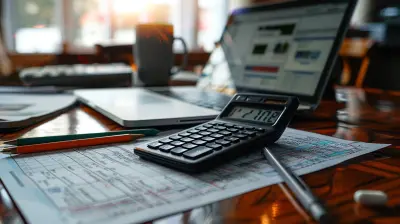Techniques for Tracking Your Spending to Improve Budgeting
15 October 2025
Managing your money wisely starts with understanding where it goes. Have you ever reached the end of the month and wondered, where did all my money go? If so, you're not alone. Many people struggle with tracking their spending, which makes budgeting feel like an uphill battle.
But here's the good news: with a few simple techniques, you can take control of your finances, track your spending effectively, and create a budget that actually works for you. In this guide, we'll break down the best strategies for tracking your expenses, so you can finally feel confident about your money. ![]()
Why Tracking Your Spending Matters
Before we dive into the techniques, let's talk about why tracking your spending is so important.Think of your money like a leaky faucet. If you don’t pay attention, small drips here and there can add up to a surprisingly high water bill. Similarly, small, untracked expenses—like your daily coffee or those impulse Amazon purchases—can drain your budget before you even realize it.
When you track your spending:
- You become more aware of where your money is going.
- You identify bad spending habits and make better financial decisions.
- You gain control over your finances and reduce financial stress.
- You set and achieve financial goals, whether it's saving for a vacation, paying off debt, or buying a home.
Now that we understand the why, let’s explore the how. ![]()
Best Techniques for Tracking Your Spending
1. Use a Budgeting App
Technology makes tracking expenses easier than ever. Budgeting apps sync with your bank accounts and categorize your spending automatically. Some of the most popular options include:- Mint – Tracks spending, categorizes purchases, and sets budget goals.
- YNAB (You Need A Budget) – Focuses on giving every dollar a job, helping you stay mindful of your budget.
- PocketGuard – Shows how much money you have left for spending after bills and savings.
These apps provide real-time insights into your spending, so you always know where you stand financially.
2. Keep a Spending Journal
If you prefer a more hands-on approach, keeping a spending journal can be a game-changer. Simply write down every single purchase you make. It sounds tedious, but it helps you stay mindful of your spending habits.Make it easier by:
- Carrying a small notebook with you.
- Using the Notes app on your phone.
- Reviewing your receipts at the end of the day and logging them.
3. Track Spending Using a Spreadsheet
For those who love numbers and organization, a spreadsheet can be an excellent tool. You can create a simple Google Sheets or Excel file to record your spending.Your spreadsheet should include:
- Date of the expense
- Category (groceries, entertainment, bills, etc.)
- Amount spent
- Notes (why you made the purchase)
This method gives you a clear, customized breakdown of your expenses and makes it easy to analyze trends over time.
4. Separate Fixed and Variable Expenses
One reason budgeting can feel overwhelming is that not all expenses are the same. The key is to separate them into fixed and variable expenses.- Fixed Expenses – These stay the same every month, like rent, car payments, and insurance.
- Variable Expenses – These fluctuate, including groceries, dining out, and entertainment.
Once you categorize your spending, you can spot which areas are flexible and where you can cut back if needed.
5. Set Spending Limits for Different Categories
Ever wondered why you're always short on cash even when you're earning well? It’s probably because money is flowing out without any structure. Set spending limits for different categories like:- Groceries: $400/month
- Eating Out: $150/month
- Entertainment: $100/month
- Clothing: $75/month
By allocating a specific budget for each category, you prevent overspending in one area and ensure every dollar has a purpose.
6. Automate Expense Tracking with Bank Alerts
Many banks allow you to set up spending alerts that notify you when you reach a certain threshold. This is a fantastic way to stay mindful of your spending without constantly checking your account.Set up alerts for:
- Large purchases
- Low account balances
- Monthly subscriptions
This automation ensures you stay in control without the hassle of manual tracking.
7. Review Your Spending Weekly
Tracking your spending isn’t a set-it-and-forget-it thing. You have to review your spending regularly to make adjustments.At the end of each week, sit down and:
- Categorize your expenses
- Compare actual spending vs. your budget
- Identify patterns and problem areas
This weekly habit keeps you on track and prevents financial surprises at the end of the month.
8. Use the Envelope System for Cash Spending
If you prefer using cash, consider trying the envelope system. This involves:1. Withdrawing cash based on your budget.
2. Placing cash into different envelopes labeled with spending categories.
3. Only using the money from each envelope for its designated purpose.
Once an envelope is empty, you can’t spend more in that category until the next month. This method forces you to stay disciplined with your budget.
9. Identify and Cut Out Wasteful Spending
Once you start tracking your expenses, you'll probably notice unnecessary spending. Maybe it's the gym membership you never use, or multiple streaming services you rarely watch.Take action by:
- Canceling unused subscriptions
- Eating out less often
- Cutting impulse buys
Redirect that money toward savings, debt repayment, or something meaningful that actually improves your financial well-being.
10. Use a Zero-Based Budgeting Approach
Zero-based budgeting demands that every dollar is assigned a job—whether it goes toward bills, savings, investments, or entertainment. By the end of the month, your income minus expenses should equal zero (not literally, but allocated to specific purposes).This method ensures that your money works for you rather than disappearing into thin air. ![]()
Final Thoughts
Taking control of your finances starts with one simple but powerful habit: tracking your spending. It’s like using a GPS for your money—without it, you’re just driving blind.By implementing these techniques, you'll gain control, eliminate wasteful spending, and build a budget that actually works for you. Whether you use budgeting apps, spreadsheets, or the envelope system, consistency is key.
The more aware you are of your spending habits, the more empowered you become in managing your money. So, start tracking today and watch how small, intentional changes can transform your financial future.
all images in this post were generated using AI tools
Category:
Budgeting TipsAuthor:

Knight Barrett
Discussion
rate this article
1 comments
Naya Butler
Tracking your spending can feel like monitoring a toddler in a candy store—chaotic yet rewarding! With the right techniques, you'll master the art of budgeting faster than you can say 'frugal fabulous.' Let’s turn those pennies into a well-planned party!
October 19, 2025 at 11:44 AM

Knight Barrett
Absolutely! Embracing chaos can lead to financial clarity—let's turn that spending spree into savvy savings!


